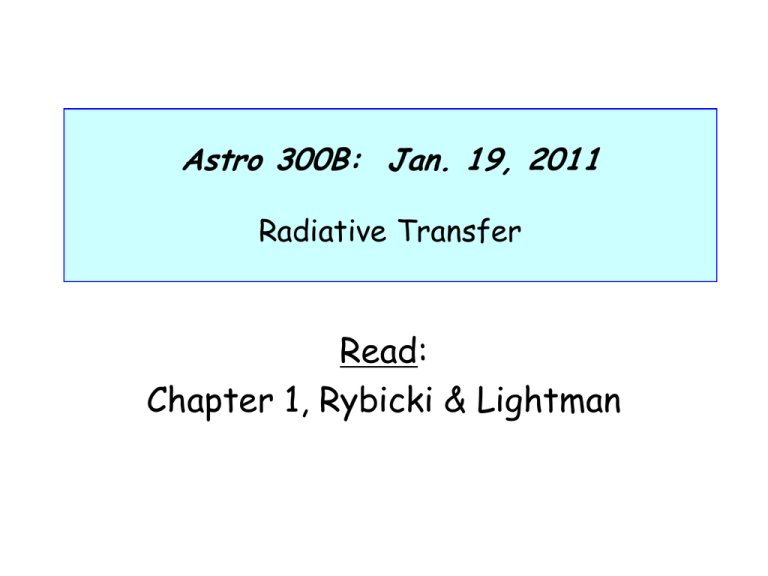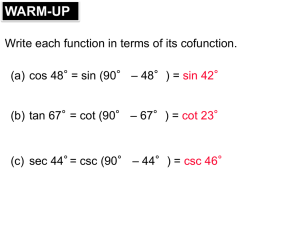PPT - University of Arizona
advertisement

Astro 300B: Jan. 19, 2011 Radiative Transfer Read: Chapter 1, Rybicki & Lightman c Light where Energy = wavelength -1 = frequency units: Hz or sec c = 3.00 x 1010 cm sec-1 velocity of light in a vacuum E h where h = 6.625 x10-27 erg sec Planck’s constant Region Gamma Ray Wavelength λ< 0.1 Å X-ray 0.1 Å < λ< 100 Å Ultraviolet 100 Å < λ< 4000Å Visible 4000 Å < λ< 7000Å Infrared 7000Å < λ<1 mm Microwave 1 mm < λ< 10 cm Radio 10 cm < λ Units and other important facts -8 • Angstrom Å = 10 -10 cm = 10 m -4 -6 • Micron µm =10 cm = 10 m -1 • Wave number = (2π)/ λ cm (number of wavelengths / distance) 1 eV = 1.6 x 10-12 ergs Jansky = 1 Jy = 10-26 W m-2 Hz -1 = 10-23 ergs s-1 cm-2 Hz-1 Radio λ=few cm VLA, GBT Mm λ = 1,2,3mm ARO 12m, Interferometers – BIMA, OVRO ALMA Submm λ = 800 microns JCMT, CSO, SMT, South Pole 230, 345, 492 GHz Mid/far IR λ = 20-350 microns Near IR λ = 1-10 microns Space only IRAS, ISO, Spitzer J: 1.25 microns H: 1.60 microns K: 2.22 microns L: 3.4 microns N: 10.6 microns Sky emission lines very bright for λ= 8000 Å – 2 µm Many atmospheric absorption features λ > 2.2 µm: Thermal emission from telescope dominates NICMOS, WFPC3 on HST JWST Shape arbitrary – see also UKIRT home page Optical: λ = 3200 Å -- 9000 Å Earth’s atmosphere opaque for λ < 3200 Å silicon (ccds) transparent for λ > 9000 Å UV: 911 Å -- Milky Way is opaque for λ < 911 Å 1215 Å Lyman alpha, n=2 n=1 for Hydrogen IUE, HST, GALEX: 1150 – 3200 Å HUT, FUSE 911 -1200 Å (MgFl cutoff) X-ray The γ- rays E = 0.2 – 10 keV E > 10 keV Einstein, ROSAT, Asca Chandra, XMM, Astro-E XTE, GRO, INTEGRAL I Definitions: 1. Specific Intensity J F p I Î Consider photons flowing in direction Î, into solid angle dΩ, centered on Î The vector n is the normal to dA Energy (ergs) dE dA cos dt d d Projection of area dA perpendicular to Î radiant energy flowing through dA, in time dt, in solid angle dΩ, in direction Î I Is defined as the constant of proportionality dE I dA co dt d d s n θ dΩ Perhaps it’s easier to visualize photons falling from the sky from all directions on a flat area, dA, on the surface of the Earth Recall polar coordinates Solid angle: dΩ = sin θ dθ dφ d units=steradian 2 0 d 0 sin d Specific Intensity I dE dA cos dt d d Comments: • units: ergs cm-2 s-1 Hz-1 steradian -1 • depends on location in space on direction F I on frequency cos d • in the absence of interactions with matter, Iν is constant • in “thermodynamic equilibrium”, Iν is the blackbody, or Planck function – a universal function of temperature T only 32 2 h c I B T ) ( h exp 1 kT Now consider various moments of the specific intensity: i.e. multiply Iν by powers of cosθ and integrate over dΩ 2. Mean Intensity J Zeroth moment J geometrical mean ofI over solid angle d 1 4 J I d 4 0 d d sin d 2 where 0 0 Comments: • Jν has the same units as Iν ergs cm-2 sec-1 Hz-1 steradian-1 Even though you integrate over dΩ Iν to get Jν, you divide by 4π • Some people define Jν without the 4 π, so the units are ergs cm-2 sec-1 Hz-1 • Jν is what you need to know to compute photoionization rates 3. Net Flux F F I cos d • Fν is the thing you observe: net energy crossing surface dA in normal direction n, from Iν integrated over all solid angle reduced by the effective area cosθ dA • If Iν is isotropic (not a function of angle), then F 0 since cos d 0 There is as much energy flowing in the +n direction as the –n direction • Also, if Iν is isotropic, then I J 4. Radiation pressure p Momentum of a photon = E/c Pressure = momentum per unit time, per unit area Momentum flux in direction θ is dF c Component of momentum flux normal to dA is dF cos c Radiation pressure is therefore p 1 c I cos2 d dynes cm-2 Hz-1 We have written everything as a function of frequency, ν However, you can also integrate these quantities over ν, either ν= 0 or ν over some passband. F ( ergs s cm ) F d 1 2 p ( dcm ynes ) p d 2 I ( ergs s cm ster ) I d 1 2 1 Iν=0 in all directions except towards the point source Fν vs. Iν Specific Intensity Point Source Iν=0 I 0 Iν=0 Fν= 0 normal to the line of sight to the point source because cosθ = 0 F 0 Fν=0 In every other direction F 0 FLUX • Uniform, isotropic, homogeneous radiation field: Fν =0 J ν = Iν • Iν • Fν is independent of distance from the source obeys the inverse square law










